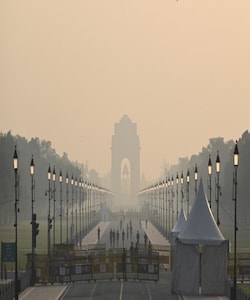
A day after Diwali, Delhi air quality turned ‘very poor’ on October 25 morning. The national capital was wrapped in a blanket of smog as the air quality remained in the very poor category with the overall air quality index (AQI) 323. (Image: AFP)
Potential polluters held the majority of board positions while there were fewer air quality experts at the State Pollution Control Boards (SPCBs) in north Indian states which are bracing for annual air pollution emergency, says a report.
Vacancies of technical positions were as high as 84 percent, hampering the monitoring of industrial compliance, the report by Delhi-based think-tank Centre for Policy Research (CPR) says.
Individuals representing potential polluters such as local authorities, industries and public sector corporations accounted for 53 percent of the members at the 10 boards analysed, raising questions of conflict of interest, according to the paper titled ‘The State of India’s Pollution Control Boards’.
Scientists, medical practitioners and academics constituted only 7 percent of the board members. The statutory requirement of having at least two board members with knowledge of and experience in air quality management was not followed by most regulators, it says.
The findings are based on information received in response to applications filed under the Right to Information (RTI) Act in August and September 2021, and a series of interviews with senior board leadership.
The report analysed the institutional structure and capacity of nine SPCBs and one pollution control committee (PCC) in the Indo-Gangetic plains, where air pollution is a major problem because of common or similar climatic conditions. Punjab, Haryana, Rajasthan, Uttarakhand, Uttar Pradesh, Bihar, Jharkhand, Chhattisgarh and West Bengal have boards while Delhi has a PCC.
The boards are the frontline regulators on matters related to air, water and noise pollution and solid waste management.
Skewed representation
“The representation from stakeholders such as urban local bodies (ULBs), industry associations and state corporations is very high while that from the public health sector, academia, medical fraternity and civil society groups representing labour, environment and health concerns is negligible,” Shibani Ghosh, fellow, CPR, and one of the authors of the report, told Moneycontrol.
Ghosh alleged potential polluters who need to be scrutinised and regulated by the board find a seat at the table. “On the other hand, those with special expertise in air quality or are affected adversely by decisions and policies made by the board do not benefit.”
High vacancies
At least 40 percent of all posts were vacant in nine SPCBs/PCC. Vacancy levels for technical positions were as high as 84 percent in Jharkhand and over 75 percent in Bihar and Haryana, which has a significant bearing on the ability of the boards to monitor industrial compliance.
Speaking on the vacancies, Ghosh said it is not surprising that the boards have to prioritise certain actions such as granting of consent over monitoring and enforcement and get little time to complete their tasks properly.
“It is important to keep in mind that a board’s mandate includes not only air pollution control but also water pollution, noise pollution and waste management.”
According to the report, the chairperson’s post was not full-time in several states. Member secretaries in at least Delhi, Jharkhand, Chhattisgarh and West Bengal were part-time and held additional charges in other departments. This means they are not able to fully focus on pollution control activities.
Several chairpersons and member secretaries have held their posts for less than a year in nearly every state, with the shortest tenure for a chairperson being 18 days (in Chhattisgarh) and a member secretary being 15 days (in Haryana and Uttar Pradesh). The frequent transfers make it challenging for them to conceptualise and deliver on long-term plans, the report said.
Ghosh said instability in the board leadership is a matter of grave concern. “The chairperson and the member secretary perform critical functions and are expected to guide its daily functioning in a manner that meets its statutory objectives.”
The problem of air pollution, though particularly palpable in north India this time of the year, is a year-round crisis with more than 80 percent of India’s population being exposed to poor air quality, Ghosh said.
“To address this crisis, we need robust regulatory institutions that can respond appropriately and effectively. The boards are our frontline pollution regulators and it is important to understand their capacity and capability constraints as we plan and implement air pollution control measures.”

